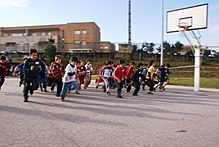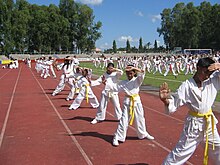PHYSICAL EDUCATION O--LEVEL BY. MWL. JAPHET MASATU.
INTRODUCTION.
This article is about the educational activity. For the TV series episode, see Physical Education (Community).
|
|
The examples and perspective in this article may not represent a worldwide view of the subject. (July 2012) |

PE equipment in Calhan, Colorado.
Contents
Trends
| This article needs additional citations for verification. (March 2013) |

Young Portuguese children participating in a school race
Another trend is the incorporation of health and nutrition to the physical education curriculum. The Child Nutrition and WIC Reauthorization Act of 2004 required that all school districts with a federally funded school meal program develop wellness policies that address nutrition and physical activity.[3] While teaching students sports and movement skills, P.E. teachers are now incorporating short health and nutrition lessons into the curriculum. This is more prevalent at the elementary school level, where students do not have a specific Health class. Recently most elementary schools have specific health classes for students as well as physical education class. With the recent outbreaks of diseases such as swine flu, school districts are making it mandatory for students to learn about practicing good hygiene along with other health topics. Today many states require Physical Education teachers to be certified to teach Health courses. Many colleges and Universities offer both Physical Education and Health as one certification. This push towards health education is beginning in the intermediate level, including lessons on bullying, self-esteem and stress and anger management.
Research has shown that there is a positive correlation between brain development and exercising.[4]
Incorporating local indigenous knowledge into physical education can lead to many meaningful experiences and a way of learning about other cultures. For example by incorporating traditional knowledge from varying indigenous groups from across Canada students can be exposed to a many concepts such as holistic learning and the medicine wheel. A unit could be focused on connecting to a place or feeling while outdoors, participating in traditional games, or outdoor environmental education. These types of lesson can easily be integrated into other parts of the curriculum and give Aboriginal students a chance to incorporate their culture in the local school community [5]
Studies have been done in how physical education can help improve academic achievement. In a 2007 article, researchers found a profound gain in student's English Arts standardized testing students who had 56 hours of physical education in a year compared to like students who had 28 hours of physical education a year.[6]
In Brazil, the physical education curriculum is designed to allow school pupils a full range of modern opportunities, dozens of sports and hundreds of carefully reviewed drills and exercises, including exposure to education with the use of pedometer, GPS, and heart rate monitors, as well as state-of-the-art exercise machines in the upper grades. Some martial arts classes, like wrestling in the United States, and Pencak Silat in France, Indonesia, and Malaysia, are taught to teach children self-defense and to feel good about themselves. The physical education curriculum is designed to allow students to experience at least a minimum exposure to the following categories of activities: aquatics, conditioning activities, gymnastics, individual/dual sports, team sports, rhythms, and dance. Students are encouraged to continue to explore those activities in which they have a primary interest by effectively managing their community resources.
In these areas, a planned sequence of learning experiences is designed to support a progression of student development. This allows kids through 6th grade to be introduced to sports, fitness, and teamwork in order to be better prepared for the middle and high school age. In 1975, the United States House of Representatives voted to require school physical education classes include both genders.[7] Some high school and some middle school PE classes are single-sex. Requiring individuals to participate in physical education activities, such as dodge ball, flag football, and other competitive sports remains a controversial subject because of the social impact these have cases physical education programs have been cut.
Technology use in physical education
New technology in Physical education is playing a big role in classes. One of the most affordable and effective is a simple video recorder. With the use of a video recorder students can see the mistakes they're making in things such as a throwing motion or swinging form.[8] Studies show that students find this more effective than having someone try to explain what they are doing wrong, and then trying to correct it.[9] Educators also found the use of other technologies such as pedometers and heart rate monitors very successful, using them to make step and heart rate goals for students.[10]Other technologies that can be used in a Physical Education setting would include video projectors, GPS and even gaming systems such as Kinect, Wii Fit and Dance Dance Revolution. Projectors can be used to show students things such as proper form or how to play certain games. GPS systems can be used to get students active in an outdoor setting and active exergames can be used by teachers to show students a good way to stay fit in and out of the classroom setting[11]
Another type of technology that is commonly used in Physical Education is the use of pedometers. Pedemeters do not necessarily track how far a person is going, but it lets them know the number of steps they are making. It will let them know how many steps on average they are making and want to strive to get more the next class. [1] There are many lessons that you can use for many grade levels when you are teaching students to use a pedometer it is important to make it a game, especially for younger students. [2]
Worldwide
In France, physical education has been a compulsory subject since 1880 and 1882 in primary school and 1925 in secondary school. Every week the pupils are taught 3 hours of PE in primary school (Ecole Maternelle et primaire), 4 hours in the first form of secondary school, than 3 hours in the 2d, 3d and 4th form (Collège) and then 2 hours per week in the 5th, 6th and 7th form (Lycée).In Australia, physical education was first made a compulsory part of the curriculum in Victorian Government primary and secondary schools in 1981. The policy was outlined in a Ministerial Statement to the Victorian Legisaltive Assembly by the Minister for Educational Services, the Honourable Norman Lacy MP on 17 September.[3]
In South Korea, it is mandatory for pupils to take a total of 3 hours of physical education through primary and secondary schools.[citation needed] South Korean educational institutions are criticized for neglecting physical education with an over-emphasis of classroom-based education.[12]
In Portugal, pupils from primary school could optionally join PE as an extra-curricular activity. From middle school to secondary school, pupils must participate in PE classes 2 hours per week.[citation needed]
In Singapore, pupils from primary school through junior colleges are required to have 2 hours of PE every week, except during examination seasons. Pupils are able to play games like football, badminton, captain's ball, and basketball during most sessions. Unorthodox sports such as touchball, fencing, and skateboarding are occasionally played. In more prestigious secondary schools and in junior colleges, sports such as golf, tennis, shooting, and squash are played. A compulsory fitness exam, NAPFA, is conducted in every school once every year to assess the physical fitness of the pupils.[citation needed] Pupils are given a series of fitness tests (Pull-ups/Inclined pull-ups for girls, standing broad jump, sit-ups, sit-and-reach and 1.6 km for primary [10-12 year-olds]/2.4 km for secondary and junior college levels [13-18 year-olds]). Students are graded by gold, silver, bronze or fail. NAPFA for pre-enlistees serves as an indicator for an additional 2 months in the country's compulsory national service if they attain bronze or fail.
In British Columbia, Canada the government has stated in the grade one curriculum that students must participate in physical activity daily five times a week. Also the teacher is responsible for planning Daily Physical Activity (DPA) which is thirty minutes of mild to moderate physical activity a day not including curriculum physical education classes. The curriculum also requires students in grade one to be knowledgeable about healthy living. For example students must be able to describe befits of regular exercise, identify healthy choices that require them to be more physically active, and describe importance of choosing healthy food.[13]
In Malaysia, pupils from primary schools to secondary schools are expected to do 2 periods or 1 hour of PE throughout the year except a week before examination. In most secondary schools, games like badminton, sepak takraw, football, basketball and tennis are available. Pupils are allowed to bring their own sports equipment to the school with the authorization of the teacher. In most secondary schools, physical exams are rarely done, but schools record pupils' height, weight and number of push-ups they can do.[citation needed]
In Scotland, pupils are expected to do at least two periods of PE in first, second, third and fourth year. In fifth and sixth year, PE is voluntary.[citation needed]
In Ireland, P.E. is mandatory for all years. Unless, the school gives the option for a student to do the Leaving Certificate Vocational Programme instead for fifth and sixth year.
In Indonesia, students ranging from Kindergarten to High School have PE integrated with their curriculum. Kindergarten until Grade 3 of Elementary students have gymnastics, starting from Grade 4 of Elementary School, students will be introduced into traditional martial arts Pencak Silat and some team games such as badminton, tennis, soccer, futsal, rounders, basketball, etc. Starting from Junior High School, Both gender are separated during PE class. PE find its place in extracurricular forms, where students can specialize themself in one kind of sports they choose. Sport Festival can be held during vacuum period, usually after examination. At this time students can compete each other by bringing own class' flag. Some universities such as ITB include PE in curriculum for freshmen

Some countries include Martial Arts training in school as part of Physical Education class. These Filipino children are doing karate.
In England, pupils are expected to do two hours of PE a week in Year 7, 8 and 9 and at least 1 in year 10 and 11.[19]
In Wales, pupils are expected to do only one hour of PE per fortnight.[20]
In Poland, pupils are expected to do at least three hours of PE a week during primary and secondary education.[21] Universities must also organise at least 60 hours of physical education classes at undergraduate courses.[22]
In India, Physical Education is an important subject in schools. Many students opt out of language subjects to chose Physical Education as a subject like English, French, and some times the official language Hindi and some time local languages because it is a very scoring subject and very entertaining to the students. Assignments on Physical education increase the interest in Sports Educational Bodies in India like Central Board of Secondary Education and Punjab School Education Board are in those which conduct examination on Physical Education in affiliated schools and colleges.[citation needed]
See also
- Adapted Physical Education
- Dance
- Health
- Sports Day
- Recreation
- Yoga
- Karate
External links
 "Educational Athletics". Encyclopedia Americana. 1920.
"Educational Athletics". Encyclopedia Americana. 1920.
|
||

No comments:
Post a Comment